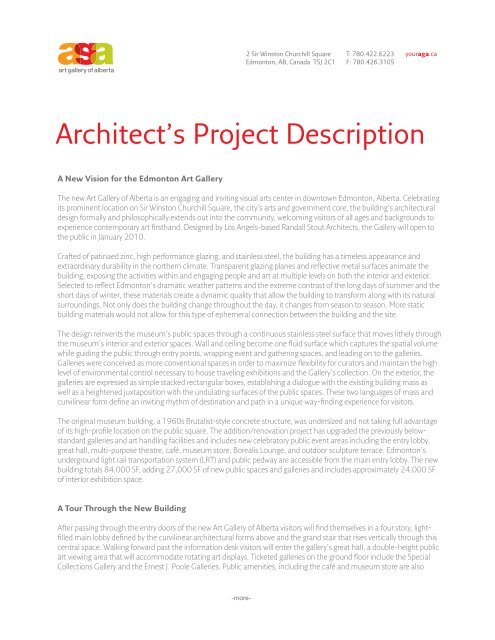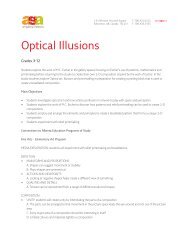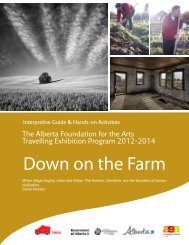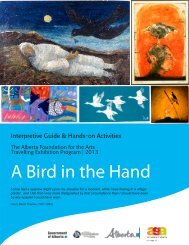Architect's Project Description - Art Gallery of Alberta
Architect's Project Description - Art Gallery of Alberta
Architect's Project Description - Art Gallery of Alberta
Create successful ePaper yourself
Turn your PDF publications into a flip-book with our unique Google optimized e-Paper software.
2 Sir Winston Churchill Square<br />
Edmonton, AB, Canada T5J 2C1<br />
T: 780.422.6223<br />
F: 780.426.3105<br />
youraga.ca<br />
Architect’s <strong>Project</strong> <strong>Description</strong><br />
A New Vision for the Edmonton <strong>Art</strong> <strong>Gallery</strong><br />
The new <strong>Art</strong> <strong>Gallery</strong> <strong>of</strong> <strong>Alberta</strong> is an engaging and inviting visual arts center in downtown Edmonton, <strong>Alberta</strong>. Celebrating<br />
its prominent location on Sir Winston Churchill Square, the city’s arts and government core, the building’s architectural<br />
design formally and philosophically extends out into the community, welcoming visitors <strong>of</strong> all ages and backgrounds to<br />
experience contemporary art firsthand. Designed by Los Angels-based Randall Stout Architects, the <strong>Gallery</strong> will open to<br />
the public in January 2010.<br />
Crafted <strong>of</strong> patinaed zinc, high performance glazing, and stainless steel, the building has a timeless appearance and<br />
extraordinary durability in the northern climate. Transparent glazing planes and reflective metal surfaces animate the<br />
building, exposing the activities within and engaging people and art at multiple levels on both the interior and exterior.<br />
Selected to reflect Edmonton’s dramatic weather patterns and the extreme contrast <strong>of</strong> the long days <strong>of</strong> summer and the<br />
short days <strong>of</strong> winter, these materials create a dynamic quality that allow the building to transform along with its natural<br />
surroundings. Not only does the building change throughout the day, it changes from season to season. More static<br />
building materials would not allow for this type <strong>of</strong> ephemeral connection between the building and the site.<br />
The design reinvents the museum’s public spaces through a continuous stainless steel surface that moves lithely through<br />
the museum’s interior and exterior spaces. Wall and ceiling become one fluid surface which captures the spatial volume<br />
while guiding the public through entry points, wrapping event and gathering spaces, and leading on to the galleries.<br />
Galleries were conceived as more conventional spaces in order to maximize flexibility for curators and maintain the high<br />
level <strong>of</strong> environmental control necessary to house traveling exhibitions and the <strong>Gallery</strong>’s collection. On the exterior, the<br />
galleries are expressed as simple stacked rectangular boxes, establishing a dialogue with the existing building mass as<br />
well as a heightened juxtaposition with the undulating surfaces <strong>of</strong> the public spaces. These two languages <strong>of</strong> mass and<br />
curvilinear form define an inviting rhythm <strong>of</strong> destination and path in a unique way-finding experience for visitors.<br />
The original museum building, a 1960s Brutalist-style concrete structure, was undersized and not taking full advantage<br />
<strong>of</strong> its high-pr<strong>of</strong>ile location on the public square. The addition/renovation project has upgraded the previously belowstandard<br />
galleries and art handling facilities and includes new celebratory public event areas including the entry lobby,<br />
great hall, multi-purpose theatre, café, museum store, Borealis Lounge, and outdoor sculpture terrace. Edmonton’s<br />
underground light rail transportation system (LRT) and public pedway are accessible from the main entry lobby. The new<br />
building totals 84,000 SF, adding 27,000 SF <strong>of</strong> new public spaces and galleries and includes approximately 24,000 SF<br />
<strong>of</strong> interior exhibition space.<br />
A Tour Through the New Building<br />
After passing through the entry doors <strong>of</strong> the new <strong>Art</strong> <strong>Gallery</strong> <strong>of</strong> <strong>Alberta</strong> visitors will find themselves in a four story, lightfilled<br />
main lobby defined by the curvilinear architectural forms above and the grand stair that rises vertically through this<br />
central space. Walking forward past the information desk visitors will enter the gallery’s great hall, a double-height public<br />
art viewing area that will accommodate rotating art displays. Ticketed galleries on the ground floor include the Special<br />
Collections <strong>Gallery</strong> and the Ernest J. Poole Galleries. Public amenities, including the café and museum store are also<br />
-more-
2 Sir Winston Churchill Square<br />
Edmonton, AB, Canada T5J 2C1<br />
T: 780.422.6223<br />
F: 780.426.3105<br />
youraga.ca<br />
Architect’s <strong>Project</strong> <strong>Description</strong><br />
located on the ground floor level. The multipurpose theatre and education suite are located on the <strong>Gallery</strong>’s lower level<br />
accessible from the main lobby.<br />
Moving up through the lobby by way <strong>of</strong> the grand stairs visitors arrive at the second and third levels dedicated to the<br />
display <strong>of</strong> art. The galleries on these levels are designed to accommodate a wide range <strong>of</strong> art and media. Approximately<br />
80% <strong>of</strong> the <strong>Art</strong> <strong>Gallery</strong> <strong>of</strong> <strong>Alberta</strong>’s exhibition space is planned for temporary shows and the neutral walls and floors <strong>of</strong><br />
these galleries spaces will allow the art itself, not the architecture, to be the focus. The galleries are unimpeded with<br />
structure in order to maximize curatorial flexibility for both large and small exhibitions. Back-<strong>of</strong>-house art handling<br />
spaces and state-<strong>of</strong>-the-art art elevators will accommodate the regular rotation <strong>of</strong> art in these galleries. In addition to<br />
flexible galleries, the third level includes an indoor events sculpture concourse that opens onto the outdoor sculpture<br />
terrace.<br />
The fourth and uppermost level includes the Member’s Lounge with an expansive view down to the lobby below and<br />
out to Sir Winston Churchill Square. This level also houses a consolidated <strong>Gallery</strong> administration suite, boardroom and<br />
outdoor sculpture terrace.<br />
Architectural Materials – A palate <strong>of</strong> s<strong>of</strong>t color and reflections<br />
The <strong>Art</strong> <strong>Gallery</strong> <strong>of</strong> <strong>Alberta</strong> is a building <strong>of</strong> dramatic forms and geometric complexity. With both orthogonal volumes<br />
and the curvilinear “borealis”, the careful selection <strong>of</strong> exterior surface materials brings unity to the overall architectural<br />
composition. Although distinct materials are used on each <strong>of</strong> the primary architectural elements, these materials were<br />
chosen to be complimentary and <strong>of</strong> modest contrast.<br />
Zinc<br />
The patinaed zinc has a s<strong>of</strong>t and aged quality in its appearance. It has only minor reflectivity, but enough to react in<br />
subtle ways to the color <strong>of</strong> the ambient sky and sunlight. For instance, in the morning the yellow color <strong>of</strong> sunlight adds a<br />
s<strong>of</strong>t greenish hue to the panels; on gray sky days and blue sky days the panels can shift from cool blue gray to warm grey.<br />
These subtle tonal shifts add life to a material that is also aesthetically compatible with the palette <strong>of</strong> earth tone concrete<br />
and Tindellstone throughout downtown Edmonton. The zinc-clad forms do not shout for attention in comparison to<br />
neighboring buildings, but rather adding a subtle and varied richness to the facade.<br />
Stainless Steel<br />
The stainless steel <strong>of</strong> the borealis form has a bead blasted finish that reflects color and light in a highly diffused manner.<br />
Whereas a smooth or polished stainless steel would shed unwanted visual glare and heat reflections, the finish on the<br />
borealis creates visual highlights without glare. The larger borealis surfaces reflect colors through gentle transitions that<br />
exist at the reciprocating angle <strong>of</strong> the line <strong>of</strong> sight. That is to say it behaves like a mirror, but with very “fuzzy” reflections.<br />
At some angles <strong>of</strong> view, one can see s<strong>of</strong>t blues in the metal <strong>of</strong> a blue sky overhead. In the early morning and when viewed<br />
from the east some surfaces reflect back the warm, yellow morning light. During the evening the same effect can be seen<br />
from the west with the more orange and reddish tones <strong>of</strong> sunset s<strong>of</strong>tly appearing on the metal.<br />
-more-
2 Sir Winston Churchill Square<br />
Edmonton, AB, Canada T5J 2C1<br />
T: 780.422.6223<br />
F: 780.426.3105<br />
youraga.ca<br />
AGA Opening Exhibitions<br />
Night time lighting<br />
The borealis is a two-sided form that plays two very different roles in the long daylight hours <strong>of</strong> the summer and the<br />
early night sky <strong>of</strong> the winter. During daylight hours, the conditions described above add visual interest to the face by<br />
reflecting the light and colors that vary throughout the day or from season to season. At nighttime, the exterior stainless<br />
steel predominately reflects the dark night sky allowing the white interior surfaces <strong>of</strong> the borealis to become a dynamic,<br />
welcoming illumination <strong>of</strong> architectural elements. Lit from within, the atrium glazing becomes transparent, allowing<br />
visitors and bystanders alike to see the events and activities <strong>of</strong> the museum interior.<br />
Interior finishes<br />
The overall exterior palette <strong>of</strong> metal, glass and concrete makes are extended into the interior <strong>of</strong> the building. This design<br />
choice allows for the visual continuity <strong>of</strong> the primary building forms and coloration as visitors move from the outside into<br />
the building. Once inside, visitors will realize that these more rugged exterior materials are complimented by refined,<br />
sophisticated interior finishes that add warmth, scale and texture to the public spaces and galleries. Ebonized hardwood<br />
maple floors occur in level one and level two galleries. A rich golden brown Douglas Fir wood is used extensively for<br />
wall and ceiling treatments. Glowing backlight walls are a feature <strong>of</strong> the grand stair and a warm white fabric is used for<br />
acoustic ceilings. On the fourth floor, green and blue carpet patterns set up a naturally toned horizontal plane against<br />
which the boardroom reads as a five sided object <strong>of</strong> saturated blue walls.<br />
randall stout architects, inc.<br />
<br />
w w w . s t o u t a r c . c o m<br />
12964 Washington Blvd.<br />
Los Angeles, CA 90066<br />
310.827.6876 telephone<br />
310.827.6879 facsimile
















